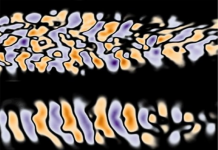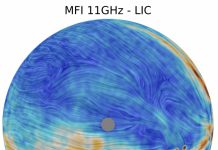Astronomers have used the Atacama Large Millimeter / Submillimeter Array (ALMA) to detect the magnetic field of a distant galaxy, whose light has travelled over 11 billion years to reach us
The magnetic field of this distant galaxy is so far away that its light has taken more than 11 billion years to reach us, meaning we will see it as it appeared when the Universe was just 2.5 billion years old.
The discovery results offer astronomers an insight into the origins of magnetic fields in galaxies, shedding light on the formation of structures similar to our Milky Way.
Astronomical magnetic fields
Many astronomical bodies within the universe possess a magnetic field, including planets, stars and galaxies.
“Many people might not be aware that our entire galaxy and other galaxies are laced with magnetic fields, spanning tens of thousands of light-years,” says James Geach, a professor of astrophysics at the University of Hertfordshire, UK, and lead author of the study published today in Nature.
“We actually know very little about how these fields form, despite their being quite fundamental to how galaxies evolve,” adds Enrique Lopez Rodriguez, a researcher at Stanford University.
We actually know very little about how these fields form, despite their being quite fundamental to how galaxies evolve
The precise timing and rate at which magnetic fields in the galaxies come into existence during the Universe’s early stages remain uncertain.
Until now, astronomers have only mapped magnetic fields in the galaxy close to us.
Revealing a distant galaxy using ALMA
Using ALMA, in which the European Southern Observatory (ESO) is a partner, Professor James Geach and his team have now developed a fully developed magnetic field within a remote galaxy, similar in structure to what is observed nearby.
Although it is approximately 1000 times weaker than Earth’s magnetic field, this magnetic field spans a staggering distance of over 16,000 light-years.
“This discovery gives us new clues as to how galactic-scale magnetic fields are formed,” explains Geach.
The discovery of a fully developed magnetic field at such an early stage in the Universe’s history suggests that these expansive galaxy-wide magnetic fields can establish themselves swiftly during the stage of young galaxies still growing.
Affecting galaxy formation
The team posits that the rapid formation of these fields might have been driven by the intense star formation occurring in the early Universe.
Additionally, these magnetic fields can impact the processes by which subsequent generations of stars come into being.
these magnetic fields can impact the processes by which subsequent generations of stars come into being.
Researchers have explained how this discovery opens a new window into the inner workings of galaxies as magnetic fields are linked to the material that is forming new stars.
To make this groundbreaking discovery, the research team observed light that originated from dust particles within a remote galaxy called 9io9. Dust grains within galaxies tend to align when a magnetic field is present, causing the emitted light to polarise, meaning the light waves oscillate in a preferred direction.
When ALMA detected and mapped this polarized signal from 9io9, it confirmed the existence of a magnetic field in a very distant galaxy for the first time.
The aspiration is that through this discovery and future observations of remote magnetic fields, the enigma surrounding the formation of these fundamental characteristics in the galaxy can be unravelled.
Editor's Recommended Articles
-
Must Read >> Exploring the mechanism of cosmic magnetic fields














